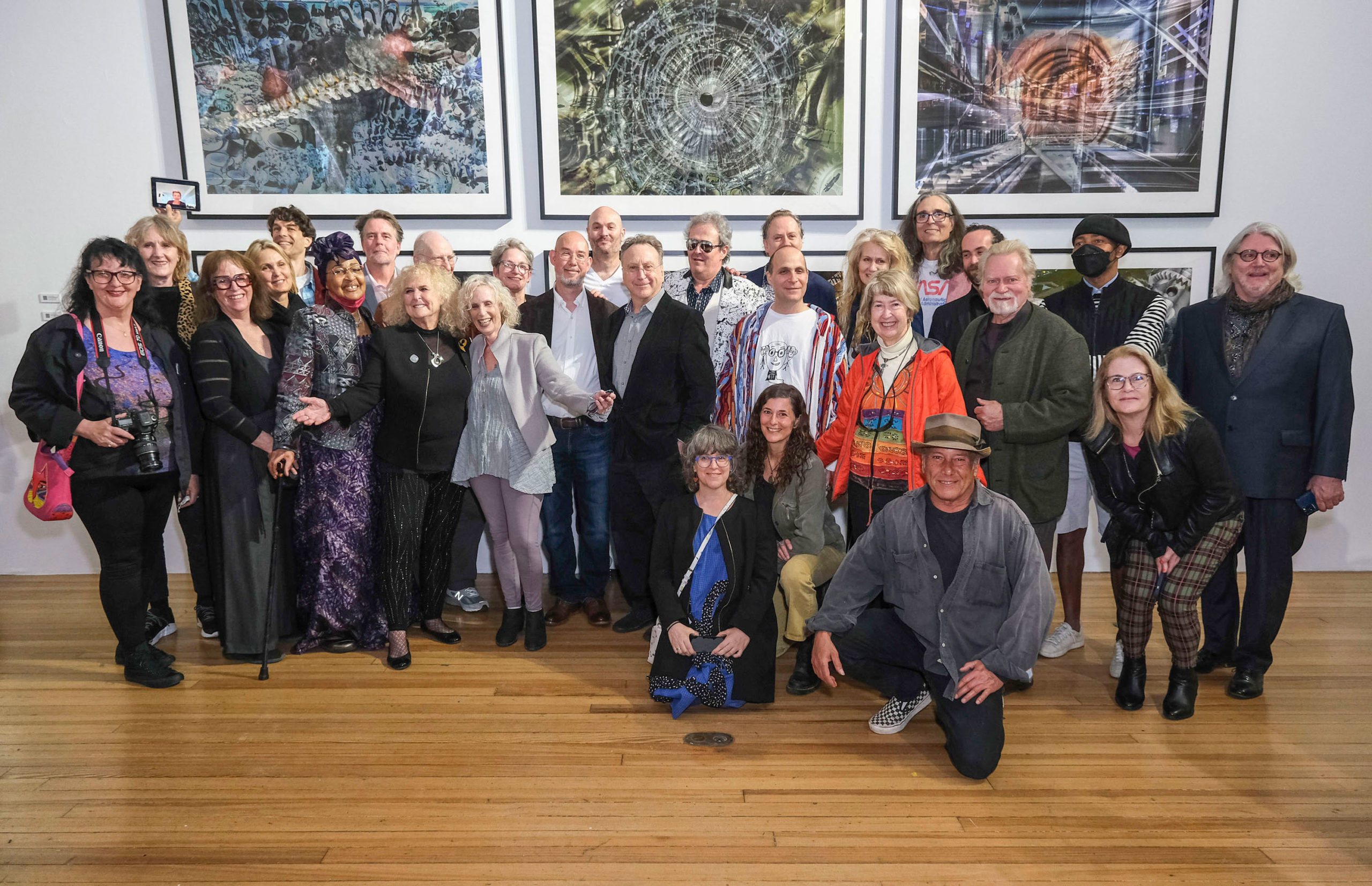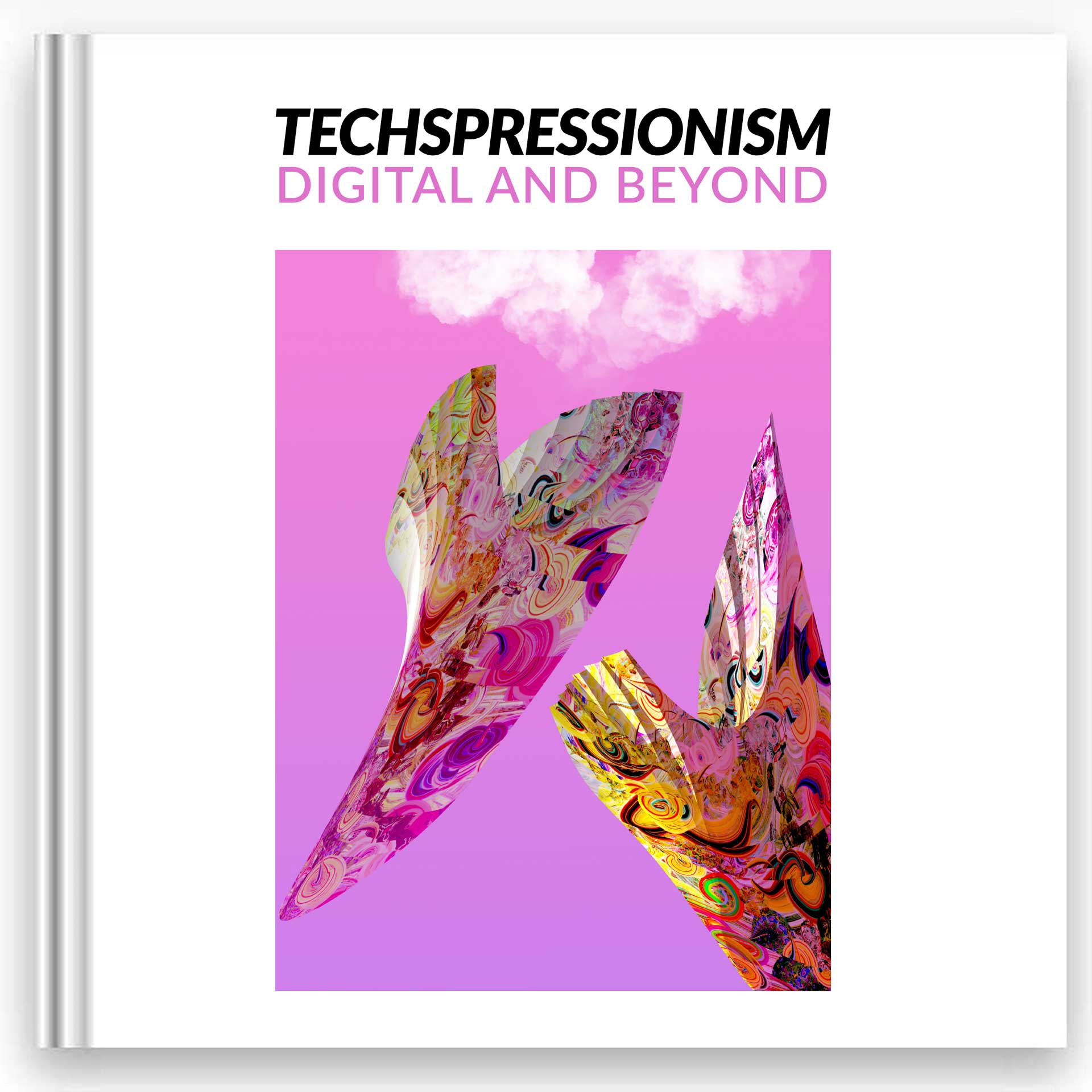Use mouse/trackpad & arrow keys to navigate on desktop, tap and drag on mobile.
In 1928, ruminating on the rapid pace and profound nature of change in the twentieth century, the French poet and philosopher Paul Valéry wrote: “We must expect great innovations to transform the entire technique of the arts, thereby affecting artistic invention itself and perhaps even bringing about an amazing change in our very notion of art.” This prediction so impressed the cultural critic Walter Benjamin that he used it as the epigraph of his famous 1935 essay, “The Work of Art in the Age of its Technological Reproducibility” (as it was originally titled). These writers and others were pondering the same issues that face the artists who now, nearly a century later, self-identify as Techspressionists.
Thanks to digital technologies and the Internet, works of art have become, in Valéry’s formulation, ubiquitous; as he foresaw, “We shall only have to summon them and there they will be.” This level of accessibility requires us to adopt and accept new attitudes toward creative expression. As Benjamin observed, the debate regarding the artistic validity of new media, begun with photography and cinema in the late nineteenth century, centers on the so-called aura of the singular work of art. And the aura of uniqueness remains powerful. Yet a digitally-generated artwork is not a reproduction in the conventional sense—that is, a copy of something else—though it can be, and often is, reproduced in multiples that are indistinguishable one from another.
Hand-made versus mechanical. One-off versus duplication. Such binaries ultimately resolve in light of the works of art themselves. By whatever technique it’s created, Techspressionist imagery generates its own aura, deriving its authenticity from the artist’s intention. Expression is paramount; technology is merely the delivery system. Jackson Pollock faced a similar concern. Frustrated by the focus on his materials and methods rather than the content of his paintings, he insisted, “It doesn’t make much difference how the paint is put on as long as something is being said. Technique is just a means of arriving at a statement.”
Helen A. Harrison
Director, Pollock-Krasner House and Study Center
June 2022

Techspressionism: Digital and Beyond opening reception at Southampton Arts Center, April 23, 2022.
Pictured artists (left to right): Diane Marsella, Carter Hodgkin, Renata Janiszewska (on iPad), Darcy Gerbarg, Mary Boochever, Tommy Mintz, Verneda Lights, Tom Dunn (SAC Executive Director), Nina Sobell, Roy Nicholson, Nina Yankowitz, Roz Dimon, Colin Goldberg, ScoJo, Steve Miller, Patrick Lichty, Tali Hinkis (kneeling), Christine Sciulli (kneeling), John Zieman (back row), Kyle Lapidus, Mary Ann Strandell, Holly Gordon, Michael Rees (back row) Dalton Portella (kneeling), Joe Diamond (SAC General Manager), Dan Welden, Paul D. Miller aka DJ Spooky, Anne Spalter, Gregory Little. Artworks behind group by Frank Gillette. Photo ©2022 Rob Rich/SocietyAllure.com
Drone Footage Courtesy Joanna Steidle // Hamptons Drone Photos
INSTALLATION IMAGES
Phographs by Jeff Heatley/AAQ East End unless otherwise noted. View full portfolio at AAQEastEnd.com.
EXHIBITION REEL
The exhibition reel is a curated selection of NFT’s, time-based works and digital still images, and is approximately one hour and nine minutes in duration. For the exhibition, the reel was installed as a looping video installation on a single screen in the Main Gallery.
Techspressionism: Digital and Beyond was the first large-scale physical group exhibition of techspressionist artworks. The exhibition includes a selection of paintings, sculptures, NFTs, time-based works, digital still images, installation works and prints.
The term Techspressionism was coined in 2011 by artist and curator Colin Goldberg. It was first described as a movement in the WIRED article “If Picasso Had a MacBook Pro” in 2014.
Techspressionism: Digital and Beyond includes the works of over 90 artists working with technology from more than 20 countries around the world including Afghanistan, Australia, Belgium, Brazil, Canada, Canary Islands, Czech Republic, France, Germany, Hong Kong, India, Iran, Italy, Netherlands, Peru, Puerto Rico, Russia, Taiwan, Turkey, Uganda, Ukraine and the United States.
Notable contemporary artists (as defined by Wikipedia) included in Techspressionism: Digital and Beyond include Victor Acevedo, Suzanne Anker, Frank Gillette, Clive Holden, Patrick Lichty, Chalda Maloff, Paul D. Miller aka DJ Spooky , Steve Miller, Joseph Nechvatal, Michael Rees, Christine Sciulli, Nina Sobell, Anne Morgan Spalter and Nina Yankowitz.
The exhibition includes NFT’s from the following artists: Victor Acevedo, Michaël Borras AKA Systaime, Tor Burwell, Dubwoman aka Giovanna Sun, Roz Dimon, Colin Goldberg, Clive Holden, Le Chat Noir, Seungjin Lee, Frederic Pons, Prïnce Magnølia x St Rivera, Lee Schnaiberg, Skywaterr, Andy Thomas, Tintin23X
ARTIST INTERVIEWS
Malavika Mandal Andrew, Suzanne Anker, Davonte Bradley, Roz Dimon, Brandon Gellis, Darcy Gerbarg, Carter Hodgkin, Renata Janiszewska, Karen LaFleur, Patrick Lichty, Gregory Little, Randi Matushevitz, Steve Miller, Tommy Mintz, Paul D. Milller aka DJ Spooky, Joseph Nechvatal, Michael Pierre Price, Michael Rees.
Over the past three years, Techspressionism has grown from a meeting of four artists and an art historian into an international movement of artists working with technology from more than 40 countries. Since the Summer of 2020, there have been over 65K posts published on Instagram using the hashtag #techspressionism.
“The search for effective means of visualizing subjective, intangible content goes back to the early 20th century expressionists. Jackson Pollock and his generation took it to new levels of abstraction. The techspressionists in this exhibition are carrying it forward, using innovative tools and techniques to communicate their personal visions.”
Helen Harrison
Director, Pollock-Krasner House and Study Center




